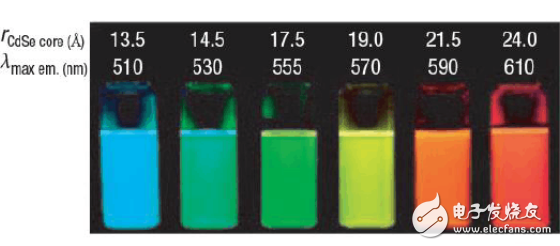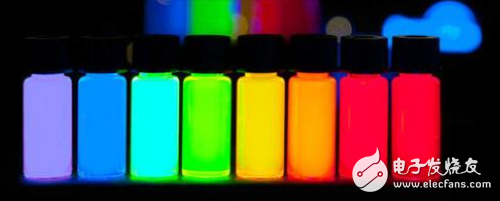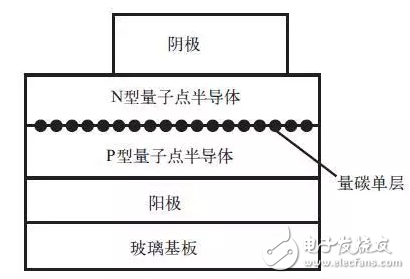Quantum dots are semiconductor nanostructures that bind conduction band electrons, valence band holes, and excitons in three spatial directions. Quantum dots, electron motion is limited in three dimensions, so it is sometimes called "artificial atom", "superlattice", "super atom" or "quantum dot atom", which is a new one proposed in the 1990s. concept. This constraint can be attributed to electrostatic potential (generated by external electrodes, doping, strain, impurities), the interface of two different semiconductor materials (eg in self-assembled quantum dots), the surface of a semiconductor (eg semiconductor nanocrystals) ), or a combination of the above. Quantum dots have a separate quantized energy spectrum. The corresponding wave function is spatially located in the quantum dot but extends over several lattice periods. A quantum dot has a small number of (1-100) integer pairs of electrons, holes, or holes, that is, the amount of electricity it carries is an integer multiple of the elemental charge. The principle of luminescence of quantum dots is similar to that of conventional semiconductor luminescence. The carriers in the material reach the excited state after receiving the external energy. When the carriers return to the ground state, the energy is released. This energy is usually light. The form is launched. Unlike conventional luminescent materials, quantum dot luminescent materials also have some of the following features. Semiconductor quantum dots are mainly composed of IIB-VIA, IIIA-VA or IVA-VIA group elements. The quantum dot luminescence spectra of different sizes and materials are in different band regions. For example, the luminescence spectrum of ZnS quantum dots of different sizes basically covers the ultraviolet region, and the luminescence spectrum of CdSe quantum dots basically covers the visible region, while the luminescence spectrum of PbSe quantum dots basically covers the infrared region, as shown in the following figure. Even the same quantum dot material has different luminescence spectra depending on its size. Taking CdSe as an example, as shown in the following figure, when the radius of CdSe particles increases from 1.35 nm to 2.40 nm, the wavelength of emitted light increases from 510 nm to 610 nm. Same size CdSe quantum dots and their luminescent photos The spectral range that enables the quantum dot to reach the excited state is wide, and the quantum dot can be excited as long as the excitation light energy is higher than the threshold. And regardless of the wavelength of the excitation light, the emission spectrum of the quantum dots of the fixed material and size is fixed, and the emission spectrum range is narrow and symmetrical. The peak of the quantum dot material emission spectrum is usually red-shifted relative to the peak of the absorption spectrum, and the difference between the peak of the emission and absorption spectrum is called the Stokes shift. Instead, it is called the anti-Stokes shift. Stokes shift is widely used in the detection of fluorescence spectral signals. The Stokes shift of quantum dots is larger than that of conventional materials. The luminescent properties of quantum dots are caused by the interaction of electrons, holes and their surroundings. When the excitation level exceeds the band gap, the quantum dots absorb photons to cause electrons to transition from the valence band to the conduction band. The UV-visible spectrum of quantum dots has many energy levels. The first visible peak is called the quantum-limited peak and is generated by the lowest energy level excitation. In addition, many electronic states exist at higher energy levels, thus allowing a single wavelength of light to simultaneously excite multiple color quantum dots. Influenced by the quantum size effect, the principle of luminescence of semiconductor quantum dots is shown in Figure 3. When a beam of light is irradiated onto the semiconductor material, the semiconductor material absorbs the photons, and the electrons on the valence band transition to the conduction band. The electron can also be converted into a valence band to emit photons, or it can fall into the electronic trap of semiconductor materials. When electrons fall into deeper electron traps, most of the electrons are annihilated in a non-radiative form. Only a very small number of electrons transition to the valence band or absorb a certain amount of energy in the form of photons, and then return to the guide. band. Quantum dots are the basic material for QLED luminescence. There are two main forms of QLED illumination: one is to use the GaN-based LED as a light conversion layer, and effectively absorb the blue light to emit light of various wavelengths that are precisely adjustable in the visible range; the second is to use its electroluminescence form. It is applied between the film electrodes to emit light (see the figure below). 1.8 Port Ming Rig Frame: The mining rig frame comes with 8 GPU ports, which means you can install 8 pcs of GPUs on the Motherboard at the same time. mining rig rental,asic mining rig,gpu mining rig for sale,mining rig asic,mining rig frame diy Easy Electronic Technology Co.,Ltd , https://www.yxpcelectronicgroups.com



2.Powerful Cooling Fans: The mining rig case is equipped with 5 high flow cooling fans, accelerating the air convection, excellent heat dissipation performance, keep the graphics card running at high performance.
3.Generous Space between GPUs: The gap between GPU ports is 65mm large, making it quieter and easier to cool.
4.Premium Material: The 8 GPU mining rig frame is made of quality steel, strong, durable, and available for repeated addition, Easy to set up, Its a stable machine thats incredibly easy to set up and requires little maintenance.
5. Application: Support TX/M-ATX/Mini ATX, ATX PSU.
It supports RTX 3060TI 3070 3080 3090 6800/6800XT 6900/6900XT etc (Except 3060, because 3060 GPU need dedicated motherboard).